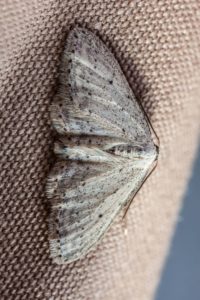Cleaning and Storing Garments to Prevent Insect Damage
Cleaning and Storing Garments to Prevent Insect Damage
Direct damage occurs when insects such as webbing cloth moths, casemaking cloth moths, and sometimes termites, feed directly on the fabric. This group of insects attacks wool, mohair, natural bristles, fur, feathers, and down. They also damage blended fibers such as wool/polyester – dispelling the notion that the use of synthetic fibers immunizes the fabrics against insect damage.
 Indirect damage occurs when insects such as silverfish, beetles, and roaches feed on leftover food, perspiration, beverage spills, and starch on the fabric. For this reason, any stains, especially food and beverage residue, should be removed from a garment before it is stored. Prevention of insect damage includes cleaning garments and using mothballs or cedar chests. Cleaning discourages insects from making their home in your garments. Although most forms of moth life are destroyed by dry-cleaning solvents during cleaning, moth larvae can attack fabrics once the solvent evaporates.
Indirect damage occurs when insects such as silverfish, beetles, and roaches feed on leftover food, perspiration, beverage spills, and starch on the fabric. For this reason, any stains, especially food and beverage residue, should be removed from a garment before it is stored. Prevention of insect damage includes cleaning garments and using mothballs or cedar chests. Cleaning discourages insects from making their home in your garments. Although most forms of moth life are destroyed by dry-cleaning solvents during cleaning, moth larvae can attack fabrics once the solvent evaporates.
Using moth balls or cedar chests or chips can help prevent insect damage. The odor of mothballs may repel larvae and insects if the area of use is enclosed, thus ensuring a high concentration of odor. Suspend the mothballs above the garments; do not place them directly on the garments. The scent of cedar chests or chips repels insects, but it is the air tightness of the chest that protects the garments from insect damage.
One problem with using mothballs is the lingering odor after the garments are removed from storage. Try hanging the garments outside for several days after removal from storage. If hanging outside won’t remove the mothball odor, ask us to remove the odors*. In some cases we may need to use an ozone generator. Ozone generators work by passing dry air through a high frequency electrical field. The resulting electrical discharge splits an oxygen molecule into two free atoms, allowing them to combine with an oxygen molecule that has not been split to form ozone. The contact between ozone and the odors embedded in the textiles causes oxidation to recur, eliminating the odors and releasing oxygen.
Your garments will love you for not leaving them to the moths.
Source: DLI
